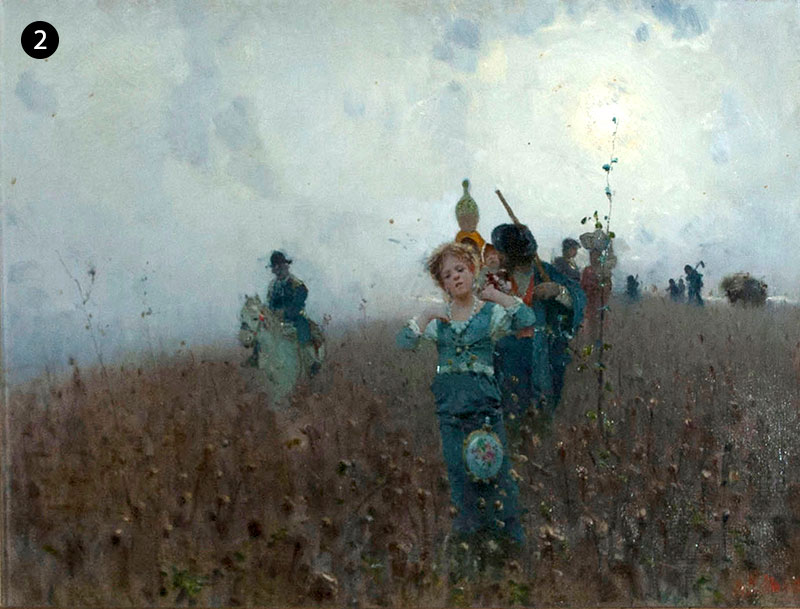The Paul Peck Alumni Center at 32nd and Market streets was originally designed by the great Frank Furness (1839-1912) in 1876 as the Centennial National Bank. The building today serves as the home of the Office of Alumni Relations and is used regularly for various University events. The building’s central Gallery, the room where bank employees once kept the bank’s records, also happens to be home to some of the finest items from the Drexel Collection—items that we’ll explore in more detail here.
- While Furness’ original building was completed in 1876, new wings were added both in 1899 by Frank Miles Day and in 1956 by Bud Ross. Many original elements remain, however, especially here in the Gallery; the most signature Furness on display here are his use of bold colors of red and blue on the metal beam and wooden columns and the decorative brickwork below the brilliant blue ceiling.
- Through the Fields, c. 1900, by Francesco Paolo Michetti (1851-1929): Francesco Paolo Michetti studied at the Academy in Naples. Abruzzo, a region in central Italy, was his inspiration. His paintings captured its people, animals and local events in luminous color and vibrant light with atmospheric effects. This scene shows a group of children marching through a field of wheat and poppies.
- A Summer Day in Venice, 1880, by Rubens Santoro (1859-1942): Rubens Santoro, the son of an artist, enrolled in the Institute of Fine Arts in Naples. He traveled throughout Italy and painted from life and subjects taken from his travels. He is most well-known for his views of Venice. This canal scene in Venice, filled with light and color, shows a woman in a gondola on shimmering waters.
- Figures in the Choir of a Cathedral, 1849, by Jules Victor Génisson: Génisson was born at St. Omer, France to Flemish parents. He received his artistic training at the Antwerp Academy and specialized in architectural subjects, especially Belgian cathedrals. He traveled throughout France, Italy, Germany and Great Britain. His architectural paintings reveal his excellent draftsmanship, his skill with unity of color and perfect perspective.
- After the Wedding, 1880, by Julius LeBlanc Stewart (1855-1919): Stewart moved to Paris with his family in 1865. Since his father was an art collector, Julius studied with important artists in Paris. His first well-known painting, After the Ball, was commissioned by A. J. Drexel. He was so pleased with the painting he commissioned Stewart for the painting, After the Wedding.
- According to Drexel legend, this painting purportedly depicts the marriage of a Drexel family member. The boy at the base of the steps is wearing a Peter Thompson Sailor Suit, very popular with young girls and boys at the time, and supposedly designed by an English tailor in America for Anthony J. Drexel’s son George.







